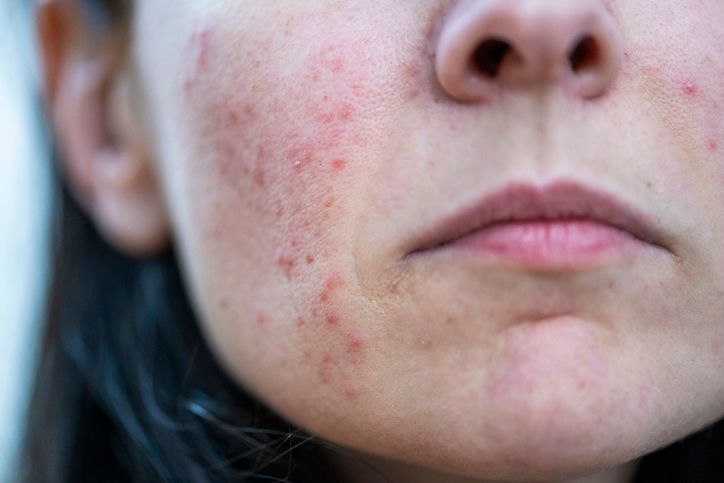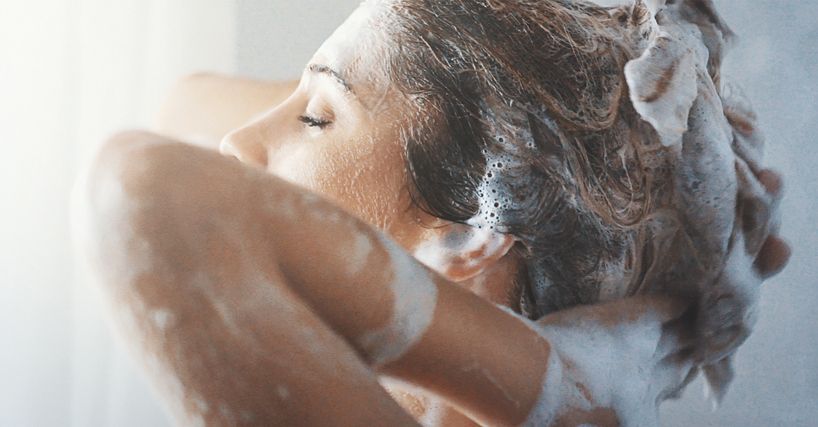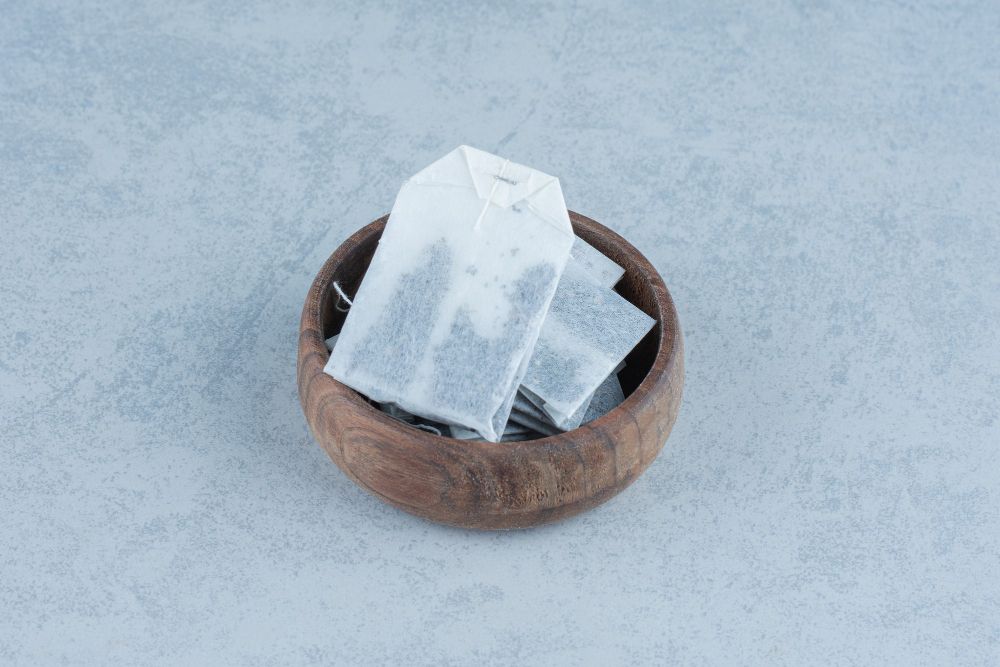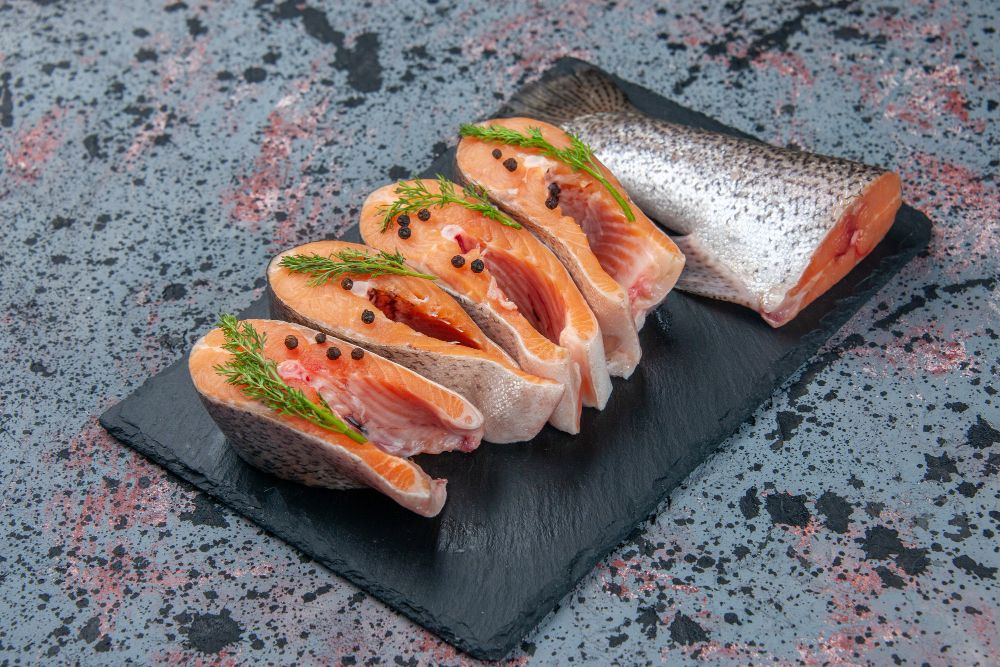
Book Now to Experience
Acne Treatment
1 Minute Self-Registration
Date should not be before minimal date
Author: Sophia Man|Updated: 23 July 2024
Have you ever noticed tiny white bumps around your eyes or on your face? Like most people, you might have tried to poke or squeeze them, thinking they are just pimples or whiteheads. However, you found them firm and hard to squeeze out. In this case, you might be dealing with milia. Don't worry! Like acne, milia is a very common and mostly benign skin condition. Do you want to know what milia are, how you get them, and how to prevent and get rid of them? Then you've come to the right place! We will even let you in on the most powerful and safe method for getting beautiful, milia-free skin!
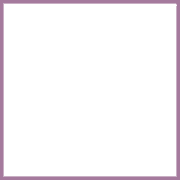
1
What are milia
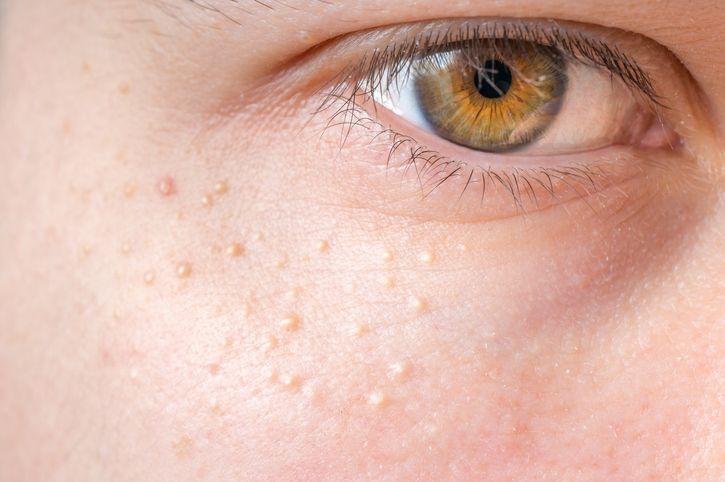
Milia are small, benign cysts (usually 1 to 4mm in diameter). The outer skin cells grow and entrap the dead skin cells and keratin (skin-building protein) that haven't fallen off, causing them to clog the hair follicles and harden into white bumps.
Clogging happens due to slow skin renewing cycles, which can occur to random skin lesions from time to time.
Also known as milk spots, milia are typically about the size of a water droplet, and are firm and smooth to the touch. These dome-shaped bumps are harmless and not painful.
Perhaps the biggest difference between milia and whiteheads or pus-filled acne is that milia are difficult to squeeze out. Trying to pick at milia by force can hurt a LOT. What's more, the "pus" you squeeze out is small, round and hard, unlike that of a pimple.
You will most likely notice milia on your face, especially around the eyes, at the sides of the nose, at the corners or inside the mouth, on the cheeks or the forehead. Sometimes, milia can also develop in the chest, on the limbs or in the private areas.

2
Who gets milia and why?
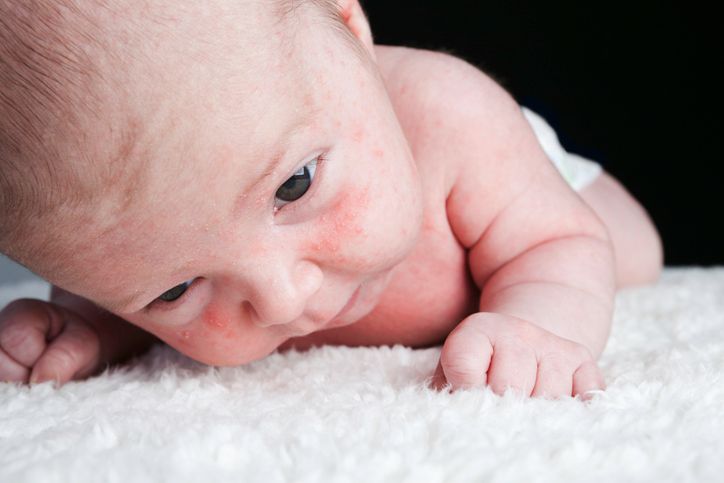
You can get milia no matter your age or skin type!
Primary milia are the most common type of milia. It can happen to all ages - from newborns to older adults. Primary milia occur randomly and subside within weeks to months. Still, sometimes primary milia can stay longer than they are welcomed.
Newborn babies are most prone to milia. Neonatal milia (aka primary milia or baby acne) is a type of primary milia found in over 50% of babies. The newborn skin is still developing, and the hair follicles are not fully grown, making clogging very easy. You will likely see baby acne on a baby's face, especially around the eyes, around the nose, and at the corners of the mouth.
Genetics and medical conditions are often associated with milia appearance.
Juvenile milia mean frequent milia appearance due to rare genetic skin conditions often emerging in childhood. Examples of these skin conditions include Pachyonychia congenita (PC), Gardner's syndrome, Bazex-Dupré-Christol syndrome (BDCS), and Nevoid basal cell carcinoma syndrome (NBCCS).
Milia en plaque is a similar condition to juvenile milia as it is inherited. Milia en plaque is triggered by autoimmune skin diseases (i.e. discoid lupus, lichen planus). Milia en plaque is most common among middle-aged women, and is identified by a tight pack of milia in a skin area, typically over the head, on the eyelids, jaw and neck.
Multiple eruptive milia is a condition in which many milia cover a large skin area, resulting in broad milia lesions. These milia lesions can be itchy and usually last for weeks and months.
Secondary milia are also known as traumatic milia. As the name suggests, secondary milia are caused by external skin damage, primarily by excessive exposure to sunlight, rashes and injuries to the skin areas. Excessive sun exposure ages up the skin and slows down the shedding of old skin cells, increasing the risk of their entrapments. Likewise, injured skin, rashes and other skin irritation disrupt regular skin metabolism, leading to milia.
Lastly, medications and products-induced milia are common. Some thick skincare products can build up on your skin and hinder proper skin cell shedding. Steroid creams can result in milia on the skin area.
Read More

3
Are Milia harmful?

You need not worry about milia affecting your health; they are mostly painless and harmless. Instead, you might fear that the milia on the face can grow noticeable, which affects how you look aesthetically.
Still, you might accidentally scratch or pick at milia and create wounds, which can get painful, inflamed or infected. For this reason, you should get rid of milia early on.

4
Can I pick at milia with a needle?
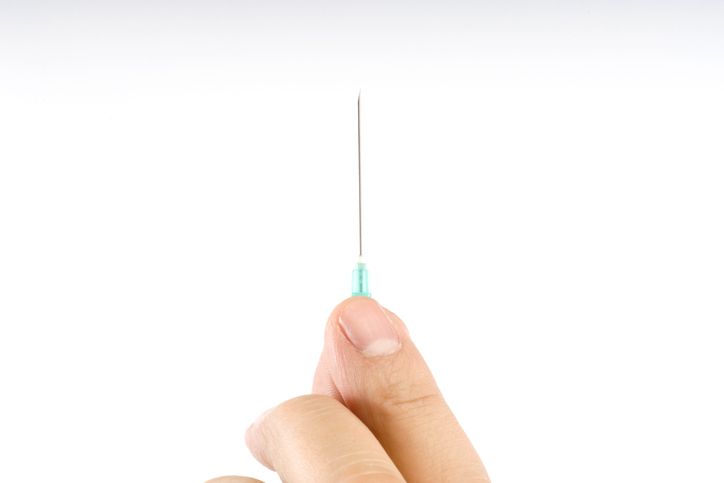
Like pimples, blackheads and whiteheads, you might be tempted to remove milia quickly using a comedone extractor. But be careful! Doing so usually causes more harm than good!
Unlike acne and comedones, you cannot scrape, squeeze out, or poke through milia so easily. Trying to do so will likely put you in great pain. Even if the pain doesn't bother you, you will need to use considerable force to pick at your skin, thus creating wounds and possible scarring.
Besides pain and permanent scarring, forceful extraction can cause discolouration, infection and eye injuries, considering how so many milia grow near the eyes.
Not to mention forceful handling of milia almost always results in their recurrence! So instead, you should learn how to handle and prevent milia properly.

Book Now to Experience
Acne Treatment
1 Minute Self-Registration
Date should not be before minimal date

5
How to prevent and treat milia?
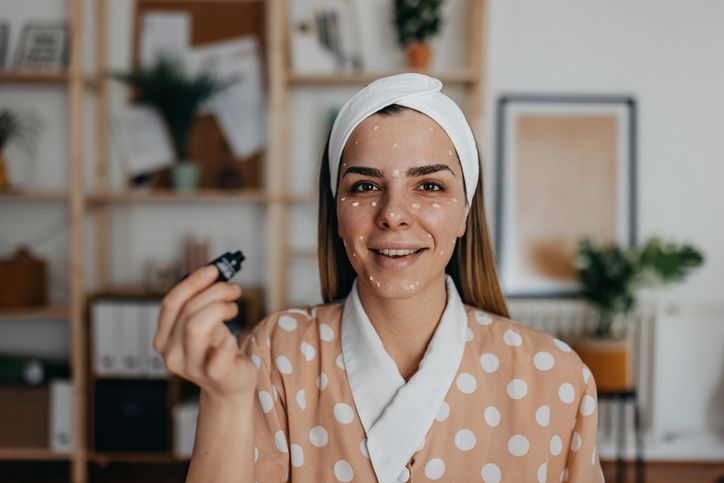
Most dermatologists agree that a combination of factors causes milia. Therefore, you will have to take multiple daily preventions.
You will need to keep at these preventions for at least months before seeing results if there are any. This depends on your body condition.
There is also a gentle medical beauty treatment for removing and preventing milia long-term!
The following prevention tips might help with preventing and clearing milia:
Sun protection
UV rays speed up your skin's oxidation process, which ages up your skin cells and slows down their shedding. As a result, layers of old and inactive skin cells pile on each other, greatly increasing the chance of milia appearance.
To prevent and shrink UV light-induced milia, you should NEVER stay under the sun for too long without proper sun protection. A sunscreen with an SPF of 30 or higher is a MUST for protecting your skin against the sunlight. You can also add hats, sunglasses or umbrellas to your fashionable wardrobe.
Exfoliate Your Skin Regularly
Sorry, but washing your face with cleanser every night is not enough cleansing. Your seemingly squeaky clean face is caked with dirt, sweat, sebum, makeup, skincare residuals, and more gunk! They add to the layers of dead skin cells and keratin, building into milia.
You may help shed milia and keratin by exfoliating twice per week. You can use chemical peels such as alpha hydroxy acid (AHA) or beta hydroxy acid (BHA) toners. AHA, such as glycolic and lactic acid, benefits dry skin. In contrast, BHA, namely salicylic acid, helps oily skin by regulating sebum secretion.
However, be careful not to apply the exfoliant too close to the eyes. Also, stop using the exfoliant if your skin becomes irritated.
Go for light-weighted cosmetic products
Lathering on face oil and thick creams might help soothe dry skin but also raise the chance of developing milia!
Heavy, oily skincare and makeup products are prone to clog your pores and harden into milia. Besides skin products, hair products such as shampoos, conditioners, hair serums, and dry shampoos can reside on the scalp, hairline, the back of the ears and the nape, resulting in milia.
If you suspect greasy products to be the cause of your milia, try replacing your creamy or oily products with light-weighted options. For example, you can select moisturizers with gel or lotion-like textures.
Choose Non-Comedogenic Skin Products
More often than not, acne and milia are caused by comedogenic skin products. These are products made of pore-clogging ingredients, some of which are:
- paraffin oil - liquid paraffin - isopropyl palmitate - myristyl myristate - octyl palmitate - decyl oleate
Some ingredients, such as petroleum, mineral oils, coconut oil and linseed oil, are not definitively proven to be comedogenic.
You should use an online comedogenic ingredient checker to examine the ingredient list of your skincare and makeup products. Get rid of the ones that fail and search for non-comedogenic alternatives.
Use Retinoids
Retinoids are derivatives of vitamin A. Oral and topical retinoids are proven effective for treating moderate to severe acne and comedones. Retinoids can also help prevent and treat milia by improving skin cell renewal, lessening clogging and controlling sebum secretion.
Keep in mind that retinoids are not for everyone. Retinoids can make your skin dry and tender, and those with more sensitive skin can experience skin irritations.
The more tolerable version of retinoids is retinol, commonly sold as an over-the-counter skincare product. Retinol is less irritating than retinoids, the trade-off being its weakened effectiveness.
Vitamin-Rich Skincare Products
Just like you need multivitamins for a healthy body, your skin should drink up its vitamins from skincare products.
Vitamin C and vitamin E are common skincare ingredients as they are powerhouses of anti-ageing. Vitamins C and E nurture the skin cells for better skin metabolism and improved collagen production, which helps shed old skin cells and keep the new skin glowy and clear of milia!
Laser Resurfacing
Laser resurfacing treatments can remove acne and improve skin texture. The laser thermal energy reaches deep into the skin to energize skin cells and activate collagen production, retrieving healthy and clear skin.
Unfortunately, the risks of laser resurfacing treatments can be as potent as their effects. Therefore, you must find an experienced and professional beauty therapist to perform laser treatments; otherwise, you will be in danger of burns, wounds, post-inflammatory hyperpigmentation, and scarring.
Laser treatments for milia around the eyes are especially dangerous, as even a tiny misstep can hurt your eyes and impair your eyesight!

6
Gentle yet powerful, erases and prevents milia naturally: The Acne Treatment

Do you want to:
- remove milia quickly, - maintain clear, glowy skin for a long time, and - improve your skin painlessly, naturally, and non-invasively?
The Acne Treatment by New Beauty uses two-way spiral suction and drainage technology to deep-cleanse and exfoliate your skin. This technology sucks out all dead skin cells and impurities to unclog your pores and dissolve existing milia.
A medical-grade hydrating serum will then be infused deep into your skin. This helps to boost its water content, calm oil secretion, energize skin cells and encourage collagen production.
With as little as 5 treatment sessions, your skin will be bouncy, luminous and milia-free for years to come!
FAQ
What causes milia?
Unlike pimples and comedones, there is no direct cause of milia. Milia are very common among all age groups and can appear randomly. Still, some factors make milia appear more often. For example, some people have genetically milia-prone skin. Daily habits such as not using sunscreens, not exfoliating the skin, and using overly heavy skin products can also increase the chance of milia formation.
How can I prevent milia?
There are habits you can take up to reduce the chance of milia forming on your skin. First and foremost, you must wear sunscreens daily and exfoliate your skin regularly with a gentle chemical peeling agent. When choosing skincare and makeup products, opt for the light-weighted and non-comedogenic options. Look for skin products with vitamins C and E for their skin-reinvigorating benefits. You may also add retinoids or retinol to your skincare regime for more potent exfoliating and anti-ageing effects.
How does The Acne Treatment remove and prevent milia?
The Acne Treatment by New Beauty uses the painless, safe and non-invasive two-way spiral suction and drainage technology to exfoliate your skin and unclog pores, dissolving exiting milia. A medical-grade hydrating serum is then infused into your innermost skin layer, thus hydrating and vitalizing the skin cells for a better renewing cycle and collagen proliferation, resulting in vibrant, clear skin!
Who is suitable for The Acne Treatment?
The Acne Treatment is safe and non-irritating for all skin types. It is suitable for most people with milia, acne, or comedones. Still, we recommend you consult our professional skincare expert for a detailed evaluation, especially if you have skin conditions such as eczema and rosacea.
How should I take care of my skin after undergoing a session of The Acne Treatment?
First, you must not use any skin products containing AHA/BHA or brightening agents (i.e. vitamin C, retinol) for 2 weeks post-session. This is because these ingredients can be irritating to your skin. You should also avoid photothermal treatments (i.e. laser, IPL, radiofrequency) on your treated milia lesions for 2 weeks. Lastly, you should gently cleanse and nurture your skin with non-irritating and hydrating face washes, serums, moisturizers, and face masks.

Book Now to Experience
Acne Treatment
1 Minute Self-Registration
Date should not be before minimal date
Recommended Articles
COPYRIGHT© NEW BEAUTY MANAGEMENT LIMITED 2025. ALL RIGHT RESERVED.

